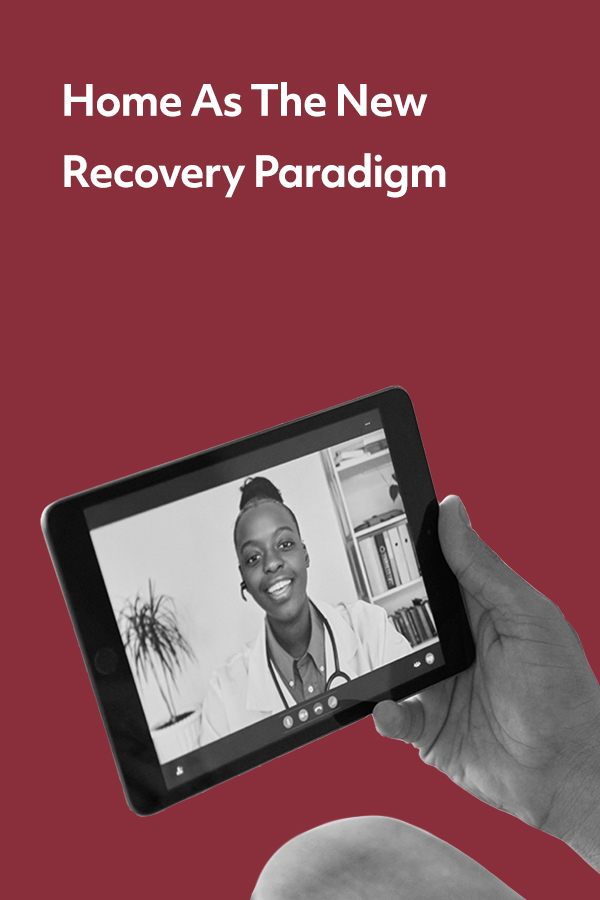Residential rehab was the accepted recovery paradigm for decades, but the advent of telemedicine has opened the door to addiction recovery at home.
“Rehab.” It’s a wildly misunderstood word. While glossy brochures depict leisurely beach strolls, poolside shiatsu, and triumphant, power-bronzed models enjoying equine therapy—this was not my reality. That said, I am grateful to have received treatment at all. Nine out of ten Americans diagnosed with a substance use disorder do not. We are a stigmatized, overlooked, and critically underserved population.
My own experience with rehab
The idea of “locking someone up,” even if voluntary, is indisputably dehumanizing. I entered my first treatment center at the age of eighteen. My roommate was a brilliant professor struggling with PTSD and pain pill dependence. By day, we were thick as thieves, but by night, she suffered from ear-shattering night terrors. More often than not, I’d awaken to her screams—at times no more than two inches from my face, ripping at my neck with her nails. The night nurses would descend on us, drag her from sight, drug her with a meaty dose of Seroquel, and lay her back in bed. This was never discussed the next morning, as night nurses did not freely communicate with day staff. This was terrifying for me and humiliating for my roommate. She relapsed within a week of “graduating” from this South Florida program. She’s no longer with us today.
Rehab is nothing like the brochure.
Take my account with a grain of salt. “Treatment” is personal, and this is my own experience. Residential rehabilitation does work for select individuals (statistically, about 21%). I’ve had many friends enter rehab broken and hopeless, and exit whole and ready for the world, abstaining from their dependence forever after.
Barriers to care reveal the need for a new kind of treatment
One layer to the problem is affordability; of the 20 million Americans diagnosed with substance use disorders, 90% don’t receive clinical help. Why? Statistics point to exorbitant and oftentimes hidden costs as the leading obstacle to treatment. The price tag of thirty-day residential rehab varies and often exceeds $20,000 for well-known centers—in exchange for antiquated treatment and unsurprisingly poor outcomes. Even if you’re insured, you’ll likely foot a shockingly high bill upon discharge.
Another obvious barrier to recovery is the lack of access. In 2020, 80% of brick-and-mortar rehab centers shuttered during the onset of COVID-19. Clinical resources—already strained—were diverted from specialty care in response to the pandemic. Waitlists grew longer, premiums went up; barriers to recovery mounted. This new reality has violently supplanted the old, demanding a new paradigm for treatment.
There is a silver lining: from chaos, a new order emerges. This pandemic has catapulted clinical programs into the twenty-first century, accelerating the implementation and adoption of telehealth solutions like Workit. Telehealth enables “anywhere, anytime” care, which is key to democratizing addiction treatment and leveling the two core barriers to entry: affordability and lack of access
Answering common questions about telehealth treatment
This magnificent shift broaches a novel array of questions regarding home-based recovery care, five of which our Workit team has done its best to answer.
What if I actually prefer an in-person clinical setting?
“At Workit we like to say, “Your Recovery, Your Way.” Expanding the options available for care doesn’t mean you can’t pick the best one for you—it simply means you have more choices. Telehealth helps to round out a dangerously limited menu of options, which historically are “white-knuckling it” and recovering alone, or entering a residential facility. One is dangerous, the other is an impossibility for most of us. Now, we have another pathway: recovery from your way, from anywhere.” Kali Lux, VP of Marketing and proud woman in recovery
My home is as personal as it gets. What if I don’t want my family member to know I’m receiving help?
“We often tell members that recovery does not mean lack of privacy. Often we have members who are not ready to share their treatment with loved ones. Our advice is to find a safe place in the home where you can meet (the bathroom usually), get headphones to keep the noise down, and ultimately let us know so we can try to respect your wishes as best as we can.” Janessa Perrin, Head of Behavioral Health
My home is not safe. What do I do now?
“Reach out to us via phone, chat, or email. We have social workers on staff who can help with finding a shelter or other housing resources, or creating a safety plan if leaving is not an option.” Janessa Perrin, Head of Behavioral Health
Will home-based and telehealth recovery care be covered by my insurance?
“More health plans are covering telemedicine than ever before. By and large, this is due to changes brought about by the Affordable Care Act. If you are unsure if telemedicine is covered for you specifically, reach out to the number on the back of your insurance card or ask your provider to verify your benefits.” Amy Wilson, Member Service Manager
Telehealth isn’t covered by my insurance. When will it be?
“During the course of the pandemic, telehealth visits offered a cost-effective treatment option for payers and a lifeline to many homebound patients. According to an analysis of 2020 BCBS of Michigan claims, telehealth use is now 20 times higher than it was prior to the pandemic …” (Source)
“Now, in light of the continuing need for SUD treatment via telehealth, lawmakers have introduced bipartisan bills to increase coverage. One notable Senate bill, the Tele-Mental Health Improvement Act, would require commercial insurers to reimburse SUD treatment providers at the same rate for telehealth and in-person visits.” Graham Vogt, Regulatory Operations Manager
View our guide to telemedicine addiction treatment for more resources.
We founded Workit years before the onset of this pandemic. If there’s one silver lining to COVID-19, it’s that Americans with substance use disorder can now more easily access affordable, effective care without leaving the privacy of home. Let’s make waiting rooms and waitlists a relic of a bygone model. We are ushering in a new paradigm of treatment and with it a new level of respect and dignity for end patients.









